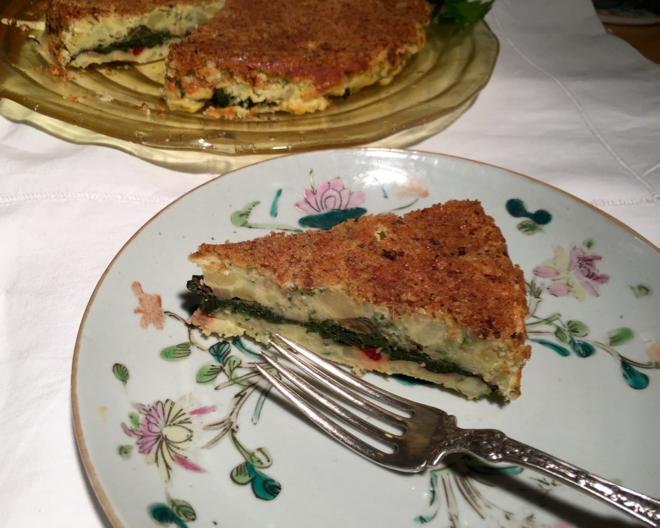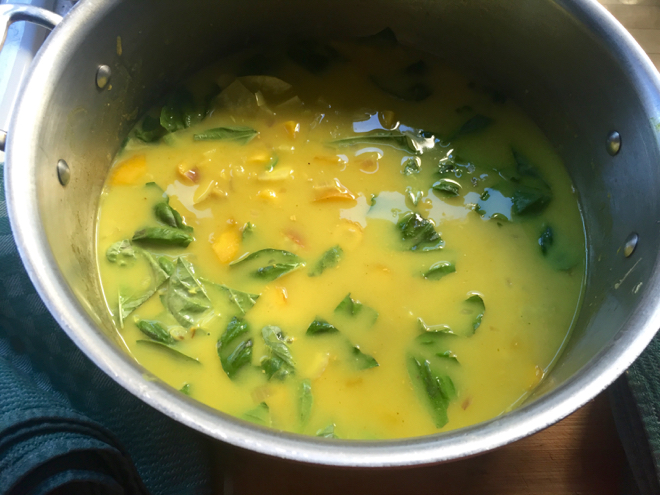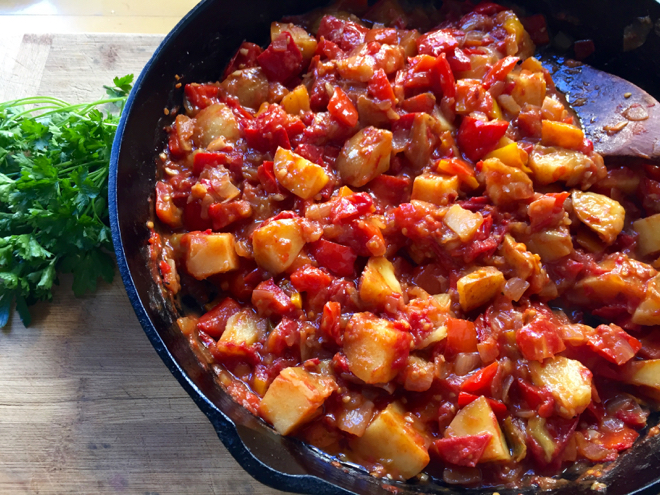Here we are! Our final week of veggies, that is until the winter share begins! Thank you for cooking alongside me again this season. I hope you’ve enjoyed the bounty as much as I have. Happy Thanksgiving!
Parsnip and Caramelized Onion Skillet Pie
Radicchio, Orange and Olive Salad
Scalloped Potatoes and Celery Root
Barley Salad with Roasted Carrots and Celery Root
Chickpea and Winter Squash Curry
Braised Kale Bruschetta
Grated Beet and Apple Salad
Beet, Celery and Walnut Salad with Garlicky Dressing
“Pumpkin” Pie (with Butternut Squash)
Parsnip and Caramelized Onion Skillet Pie
This a version of last week’s Potato and Chard Pie and is a substantial side dish or a light main dish served with a salad or two. The sweet and sour onions play nicely with the sweet, creamy parsnips for quite a rich dish. For a lighter dish you could fill it with cooked greens instead of onions. You can adapt it many other ways too; use half potatoes, half parsnips or half celery root or use rosemary instead of sage and so on and so forth.
Serves 4-5 as a main, 6-7 as a side
1 1/2 lbs parsnips, peeled and cut into chunks
2 cloves garlic, minced
Salt
4 tablespoons butter, divided
1 tablespoon olive oil
2 onions, quartered and thinly sliced
3 thyme sprigs
2 teaspoons sugar
2 tablespoons red wine or sherry vinegar
3 eggs, whisked
2 tablespoons finely chopped fresh sage or 1 tablespoon dried sage
2/3 cup fairly fine bread crumbs
Preheat oven to 375 degrees
Put parsnips in a saucepan and cover with water and add 1 teaspoon salt. Cook until nice and tender, about 15 minutes. Drain. Meanwhile mash the garlic into a paste with a generous 1/2 teaspoon salt with the side of a chef’s knife or in a mortar. Mash the parsnips with the garlic paste and 3 tablespoons butter until you have a rough puree either by hand or in a food processor. Stir in the eggs and the sage. Taste and adjust seasoning with salt if needed.
Meanwhile cook the onions over medium heat in a wide skillet with the olive oil and the thyme sprigs and a few pinches of salt, stirring often. After about 15 minutes, when the onions have softened and started browning, add the sugar and vinegar and continue cooking for 10 more minutes until caramelized. Taste and adjust seasoning.
Heat the remaining tablespoon of butter in a 9-inch well-seasoned cast iron skillet or any oven proof skillet. Swirl the butter to cover the base of the pan and evenly cover with bread crumbs. Dab a generous half of the parsnip mixture evenly over the skillet and then gently spread it evenly, taking care not to mix the breadcrumbs into the mixture. Spread the onions over the parsnips and top with the remaining parsnips and spread out evenly. Bake for about 30-35 minutes until just beginning to brown around the edges and firm to the touch. Remove from the oven and let rest for at least 5 minutes. Run a knife around the perimeter of the pie to loosen it and invert onto a serving plate. Serve warm or at room temperature.
Radicchio, Orange and Olive Salad
This is a gorgeous salad with robust flavors.
1 small to medium head radicchio, washed, dried and cut into bite-sized pieces (you want about 4 cups of radicchio)
1 orange
handful of cured black olives, pitted
2-3 tablespoons parsley leaves (optional)
1-2 tablespoons thinly sliced red/yellow onion or shallot
1 tablespoon orange juice
1 1/2 tablespoons vinegar of your choice
3 tablespoons olive oil
Sea salt and freshly ground black pepper
Cut the top and bottom off the orange and set it on one end. With a sharp serrated knife cut away the peel and pith and then cut the sections way from the membrane. Reserve any juice to add to the salad.
Put the radicchio in a salad bowl and add the orange slices, halved, if large, and the remainder of the ingredients. Toss gently and taste and adjust seasoning.
Scalloped Potatoes and Celery Root
Serves 4-6
1 1/2 lbs firm fleshed potatoes, scrubbed and thinly sliced into rounds (blade on box grater works well)
1 ½ lbs celery root, trimmed and peeled and thinly sliced
1/2 onion, finely diced
1 1/2 cups grated sharp cheddar, emmental, gruyere, . . .
2 teaspoons ground cumin
1 1/2 teaspoons pimenton (smoked Spanish paprika–spicy or mild)
1/2 teaspoon chili flakes (optional)
2 teaspoons salt
1/2 teaspoon black pepper
1/4 cup flour
About 3 1/2 cups liquid: all whole milk, part milk, part cream, part half & half, part veg or chicken stock, but be sure it’s at least 1/2 milk
Preheat oven to 400 degrees.
Put the potatoes and celery root in a large bowl. In a small bowl mix the flour and spices together. Sprinkle this over the potatoes and toss well. Add the onions and almost all of the cheese (reserving some for the top) and mix again.
Spread mixture in a 9 x 13 baking dish, pat down a bit with a spatula. Pour milk (or liquid combo) over potato mixture. The liquid should come about half way up the potatoes. Sprinkle the top with the remaining cheese, cover pan with foil and bake until vegetables are tender and easily pierced with a fork about 45- 70 minutes. Uncover after about 30 minutes and finish baking until tender and run under the broiler for a minute or two to brown the top if you’d like. Cooking time will depend on how thinly you sliced your vegetables. Let sit for a few minutes before serving. Serve hot or warm.
Barley Salad with Roasted Carrots and Celery Root
This is a hearty salad and just a good template for many variations: use roasted squash and parsnips instead of the celery root and carrots, use different herbs, different seeds or nuts, add cheese or meat, use farro or rye instead of barley . . .
I tend to have cooked grains in the freezer and sometimes roast lots of vegetables at once to have on hand for various dishes throughout the week which makes a dish like this come together in very little time. And I do my best to have a jar of this type of vinaigrette on hand as well.
Serves 4-6
3 cups cooked barley (used hulless barley from Ayers Creek farm in this version) from about 1 1/2 cups uncooked grains
1/2 medium celery root (about 3 cups diced), trimmed and cut into 1/2-inch dice
2 large carrots, cut into 1/2-inch dice, more or less
3 stalks celery with leaves (if possible), trimmed and diced
1 1/2 tablespoons olive oil
Salt
2-3 scallions, trimmed and thinly sliced (both white and green parts)
1/2 cup cilantro, chopped (or any combination of parsley, mint, basil, oregano)
1/3 cup pumpkin seeds, toasted
Vinaigrette:
2 teaspoons Dijon-style mustard
2 tablespoons red wine vinegar
1 garlic clove, minced
1/3 cup olive oil
Salt and freshly ground pepper
Preheat oven to 425 degrees.
If you need to cook the barley put it in a saucepan, cover it generously with water, add 1 teaspoon salt and bring to a boil. Turn down to a simmer and cook until the grains are tender but still have a little chew, about 35-45 minutes for hulless barley or 25 minutes for pearled barley. Drain the barley and put it in a serving dish/salad bowl.
Toss the celery root and carrots with the olive oil and sprinkle generously with salt. Spread on a baking sheet and roast for about 35 minutes or until completely tender and browning just a little. Stir once or twice while roasting to ensure even cooking.
To toast the pumpkin seeds put them in a dry skillet over medium heat and toast, stirring often, until browned and puffed up, about 5-7 minutes.
Whisk all the dressing ingredients together in a small bowl or shake up in a jar with a tight-fitting lid.
Add the roasted vegetables to the cooled barley along with the celery, scallions, herbs and toasted seeds. Pour dressing over salad and mix well. Taste and adjust seasoning with salt, pepper and/or vinegar.
Chickpea and Winter Squash Curry
The ingredient list is lengthy but this dish comes together pretty easily. The lemongrass in the dish was inspired by the inimitable Nigel Slater. This recipe makes a lot and keeps/reheats well. By all means halve the recipe if you’d like.
Serves 6+
2 tablespoons oil
1 large onion, diced
3 stalks lemongrass, trimmed and tough outer layers removed, chopped
4 cloves garlic, chopped
1 tablespoon fresh ginger, chopped
2 fresh or dried hot chilies such as serrano (if using fresh), minced or ¾ teaspoon red pepper flakes or to taste
2 teaspoons ground turmeric
2 teaspoons brown mustard seeds
1 ½ teaspoons ground coriander (or toast 1 teaspoon whole seeds if you have them in a dry skillet for a couple of minutes and then coarsely smash in a mortar)
2 delicata squash, washed, halved lengthwise, seeds and strings removed, each half halved again lengthwise and sliced in ½-inch quarter slices/chunks
3 cups cooked chickpeas
11/2 cups chickpea cooking liquid or 11/2 cups vegetable or chicken stock or water if using canned chickpeas
1 can coconut milk (preferably full fat)
Salt to taste
Cilantro, for garnish
Cooked rice (white, brown, short, grain, long grain), optional
Heat a large soup pot over medium heat with the oil. Add the onions and cook until softened, about 7 minutes. Meanwhile process the garlic, ginger, and lemongrass in a small food processor (or chop finely by hand) until well broken down—it will not be smooth. Add this mixture to the onions and cook for another 5 minutes. Add the spices and hot peppers and saute for another minute or two.
Add the squash, chickpeas, and cooking liquid, stock or water and bring to a simmer. Cook gently for about 20 minutes until the squash is tender. Stir in the coconut milk and return to a simmer for a 5 minutes. Taste and adjust seasoning. If you used water it will definitely need a bit of salt.
Serve hot with cilantro over rice, if you’d like.
Braised Kale Bruschetta
Sauté chopped kale in olive oil with a clove or two of minced garlic and a pinch of salt. Add water to keep things moist. You want the kale silky but not watery. When tender, toast slices of crusty bread and rub each piece of toast with a whole clove of garlic. Pile the kale on the garlicky toast and top with plenty of good olive oil and salt to taste.
Grated Beet and Apple Salad
–adapted from Vegan Soul Kitchen by Bryant Terry
This is a gorgeous and refreshing salad.
Serves 4 +
2 large beets, peeled
2 large apples, cored, peeled
1 tablespoon apple cider syrup, maple syrup or honey (warmed if too thick)
1 tablespoon apple cider vinegar
2 tablespoons olive oil
Sea salt
Freshly ground black pepper
1/2 cup golden raisins (or regular ones or dried currants or any dried fruit, chopped if needed)
Coarsely shred beets and apples on box grater or in a food processor fitted with large grater attachment. Put the grated apples and beets in large mixing bowl and set aside.
In a small bowl mix the sweetener, vinegar, olive oil and salt and pepper and whisk to combine. Pour dressing over grated beets and apples, add raisins and toss well. Season to taste with salt and pepper and more vinegar or sweetener, if needed.
Beet, Celery and Walnut Salad with Garlicky Dressing
I toss together a lot of beet salads, some of which make it into the recipe collection. This one, as they always do, resulted from what I happened to have on hand. Adapt as you see fit but the crunch of the celery, the sweet, robust beets and the sharp zing from the garlic is a particularly fun combination especially in the cooler months.
Serves 2-3
4 roasted (or boiled), cooled and peeled beets, cut into large dice or wedges
2 good-sized stalk celery (use some leaves if attached), washed and thinly sliced (halve the stalks lengthwise if they’re quite large first)
2 cloves garlic, minced and then mashed into a paste with some coarse salt on the cutting board with the side of a chef’s knife (or put through a press)
1/3 cup (or more) cilantro, stems and all, roughly chopped
1/2 cup toasted walnuts, roughly chopped
1-2 ounces feta, crumbled
1 scallion, thinly sliced (optional–use a little onion or shallot if that’s what you have)
1 tablespoon (or more) sherry or red wine or cider vinegar
2 tablespoons (or more) good olive oil
Salt
Whisk the mashed garlic with the olive oil and vinegar. Toss this dressing with everything else, except the beets. Gently toss in the beets. Taste and adjust seasoning.
“Pumpkin” Pie (with Butternut Squash)
I think butternut squash makes the silkiest “pumpkin” pie in fact.
This is fairly classic pumpkin pie recipe, with the exception of the sour cream and optional rum.
I swear by the Chez Pim pie crust technique and recipe (nothing but butter, flour and water). Give it a try if you’d like or use your favorite recipe/technique.
Unlike many others I do not blind bake my crust for pumpkin pie. Instead I bake it on a pizza stone in a very hot oven (for the first 15 minutes) and then reduce the temperature. This way my crust doesn’t burn and get brittle (which I find if I blind bake and then add the custard which needs a good 45 minutes to bake itself) and the bottom crust does just fine. You always get a little sogginess with a wet custard like this but I think it’s just perfect.
1 9-inch single crust Pie shell, chilled (not partially baked using ½ of above recipe or your favorite pie dough)
1 ¾ cups squash puree (from 1 small-medium butternut squash)
2 large eggs, at room temperature
3/4 cup (packed) light brown sugar
1 cup whole milk or cream
1/3 cup sour cream
or Greek yogurt
1 teaspoon ground cinnamon
1 teaspoon ground ginger
Pinch of ground cloves
Pinch of freshly grated nutmeg
Pinch of salt
1 1/2 tablespoons dark rum (optional)
1 teaspoon vanilla extract
Lightly sweetened lightly whipped cream, for topping
Preheat oven to 425 degrees.
Cut the pumpkin or squash in half and remove all seeds and strings. Keep seeds and clean and roast for a snack if you’d like. Put the pumpkin/squash cut side down on a baking sheet and bake until very tender when pierced with the tip of a knife. Remove from oven, let cool and scoop out the flesh and mash.
Center a rack in the oven and preheat the oven to 450°F. If you have a pizza stone, put it on the rack you’re going to use and then preheat. Setting the pie pan directly on the pizza stone helps the crust bake nicely and not get soggy, especially since we’re not pre-baking the crust.
Roll out your pie dough and place it in a pan, making sure to gently press the dough fully into the pan. Trim the overhanging dough with a sharp knife all around leaving at least a 1-inch overhang. Flour your fingers and crimp the dough by pushing your right pointer finger into a “v” shape created with the thumb and pointer of your left hand, holding the edge of dough. Repeat around the whole pie, re-flouring your fingers as needed, to make a pretty, crimped rim. Chill pie shell in the fridge while you make the filling.
Put all of the filling ingredients in a food processor and process for 2 minutes, stopping to scrape down the sides of the bowl once or twice and pour the filling into the chilled pie shell. Alternatively whisk all the ingredients well in a bowl.
Bake for 15 minutes at 450, then reduce the oven temperature to 350°F and continue to bake for 35 to 45 minutes longer or until a knife inserted close to the center comes out clean. (If you don’t want to create a slash in your masterpiece, tap the pan gently—if the custard just jiggles a little bit in the very center, it’s done.) Transfer the pie to a rack and cool to room temperature.
Serve the pie with lightly sweetened whipped cream



















































































